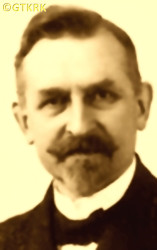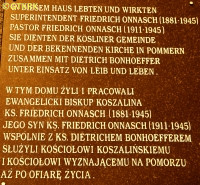Roman Catholic
St Sigismund parish
05-507 Słomczyn
85 Wiślana Str.
Konstancin deanery
Warsaw archdiocese, Poland
full list:
displayClick to display full list

searchClick to search full list by categories
wyświetlKliknij by wyświetlić pełną listę po polsku

szukajKliknij by przeszukać listę wg kategorii po polsku

Martyrology of the clergy — Poland
XX century (1914 – 1989)
personal data
surname
ONNASCH
forename(s)
Frederick Albert (pl. Fryderyk Albert)
forename(s)
versions/aliases
Frederick (pl. Friedrich)
function
pastor
creed
Lutheran Church LUmore on
en.wikipedia.org
[access: 2014.09.21]
nationality
German
date and place
of death
17.02.1945

Barlinektoday: Barlinek gm., Myślibórz pov., West Pomerania voiv., Poland
more on
en.wikipedia.org
[access: 2022.01.10]
details of death
After the national–socialist NSDAP party came to power in Germany in 1933, publicly criticized the new authorities.
Joined the so‐called Confessing Church (Germ. Bekennende Kirche), founded in 1934.
Interrogated many times.On 07.02.1934, suspended by the local bishop from his duties in Koszalin, but on 01.03.1934, after protests from his parishioners, reinstated in his duties.
On 20.04.1938, swore an oath of allegiance to the German leader, Adolf Hitler.
A year later, in 04.1939, mobilized to the German army, but after the intervention of the local authorities interrogated — as a suspect — by the political police Gestapo, locked in a single cell in prison for 10 days, then released.
After the German attack on Poland on 01.09.1939 (the Russians invaded Poland 17 days later) and the start of World War II, arrested again on 09.09.1939 — prob. in connection with a sermon delivered two weeks earlier, on 27.08.1939, and initiated prayers for those imprisoned in concentration camps.
Released, but on 12.09.1940 forced by the Gestapo to leave Pomerania with a ban on public speaking (his wife took over her pastoral duties in Koszalin).
A year later — on the order of the German RSHA special security services — began his ministry in Barlinek.
During Russian winter offensive of 1945 at the end of the World War II, after capture of Barlinek on 30.01.1945 by the Russians, shot by the Russians in his apartment that Russians ordered him and his family to leave.
cause of death
murder
perpetrators
Russians
sites and events
Ribbentrop‐MolotovClick to display the description
date and place
of birth
08.10.1881

Studźcetoday: Margonin gm., Chodzież pov., Greater Poland voiv., Poland
more on
en.wikipedia.org
[access: 2021.12.18]
presbyter (holy orders)
ordination
13.09.1907

Poznańtoday: Poznań city pov., Greater Poland voiv., Poland
more on
en.wikipedia.org
[access: 2021.07.18]
positions held
1941 – 1945
parish priest — Barlinektoday: Barlinek gm., Myślibórz pov., West Pomerania voiv., Poland
more on
en.wikipedia.org
[access: 2022.01.10] ⋄ LU parish
till c. 1940
superintendent–senior — Koszalintoday: Koszalin city pov., West Pomerania voiv., Poland
more on
en.wikipedia.org
[access: 2022.01.28] ⋄ Evangelical Church Easter region of Pomerania
1922 – c. 1940
parish priest — Koszalintoday: Koszalin city pov., West Pomerania voiv., Poland
more on
en.wikipedia.org
[access: 2022.01.28] ⋄ Holy Mary LU parish — also: president of the Fraternal Council of the Confessing Church (Germ. Bekennende Kirche) of All Pomerania (from 02.1939)
1909 – 1922
minister — Lobetaltoday: district of Bernau bei Berlin, Barnim dist., Brandenburg state, Germany
more on
de.wikipedia.org
[access: 2023.04.02] ⋄ colony for the unemployed and underprivileged under the motto „work instead of alms”
c. 1905 – c. 1907
apprentice — Betheltoday: district of Bielefeld, Bielefeld urban dist., Detmold reg., North Rhine‐Westphalia state, Germany
more on
de.wikipedia.org
[access: 2023.04.02] ⋄ Theological School — diaconal practices and workshops, i.a. prob. in a boarding school for future preachers destined to minister to the sick and the poor
till c. 1905
student — Halle an der Saaleform.: Dobrogóra
today: Halle (Saale), Halle (Saale) dist., Saxony‐Anhalt state, Germany
more on
en.wikipedia.org
[access: 2022.08.05] ⋄ Department of Theology, Martin Luther University of Halle–Wittenberg — studies crowned with the first „pro venia concionandi” exam before the Church Examination Board on 07.10.1905 in Poznań
student — Berlintoday: Berlin state, Germany
more on
en.wikipedia.org
[access: 2020.07.31] ⋄ Department of Theology, Friedrich Wilhelm University [i.e. Humboldt University (from 1949) / Friedrich Wilhelm University (1829‐1945) / University of Berlin (1809‐1828)]
student — Heidelbergtoday: Heidelberg urban dist., Karlsruhe reg., Baden‐Württemberg state, Germany
more on
en.wikipedia.org
[access: 2022.12.05] ⋄ Lat. Universitas Ruperto Carola Heidelbergensis (Eng. Ruprecht Karl University)
married — four children
author of the „Tagebuch” (Eng. „Diary”), an unpublished manuscript in the possession of the family
others related
in death
BRUNClick to display biography Ginter, HELDTClick to display biography Charles Henry, MASSOW vonClick to display biography Bertha, ONNASCHClick to display biography Frederick Charles Günter
sites and events
descriptions
Ribbentrop‐Molotov: Genocidal Russian‐German alliance pact between Russian leader Joseph Stalin and German leader Adolf Hitler signed on 23.08.1939 in Moscow by respective foreign ministers, Mr. Vyacheslav Molotov for Russia and Joachim von Ribbentrop for Germany. The pact sanctioned and was the direct cause of joint Russian and German invasion of Poland and the outbreak of the World War II in 09.1939. In a political sense, the pact was an attempt to restore the status quo ante before 1914, with one exception, namely the „commercial” exchange of the so‐called „Kingdom of Poland”, which in 1914 was part of the Russian Empire, fore Eastern Galicia (today's western Ukraine), in 1914 belonging to the Austro‐Hungarian Empire. Galicia, including Lviv, was to be taken over by the Russians, the „Kingdom of Poland” — under the name of the General Governorate — Germany. The resultant „war was one of the greatest calamities and dramas of humanity in history, for two atheistic and anti‐Christian ideologies — national and international socialism — rejected God and His fifth Decalogue commandment: Thou shall not kill!” (Abp Stanislav Gądecki, 01.09.2019). The decisions taken — backed up by the betrayal of the formal allies of Poland, France and Germany, which on 12.09.1939, at a joint conference in Abbeville, decided not to provide aid to attacked Poland and not to take military action against Germany (a clear breach of treaty obligations with Poland) — were on 28.09.1939 slightly altered and made more precise when a treaty on „German‐Russian boundaries and friendship” was agreed by the same murderous signatories. One of its findings was establishment of spheres of influence in Central and Eastern Europe and in consequence IV partition of Poland. In one of its secret annexes agreed, that: „the Signatories will not tolerate on its respective territories any Polish propaganda that affects the territory of the other Side. On their respective territories they will suppress all such propaganda and inform each other of the measures taken to accomplish it”. The agreements resulted in a series of meeting between two genocidal organization representing both sides — German Gestapo and Russian NKVD when coordination of efforts to exterminate Polish intelligentsia and Polish leading classes (in Germany called «Intelligenzaktion», in Russia took the form of Katyń massacres) where discussed. Resulted in deaths of hundreds of thousands of Polish intelligentsia, including thousands of priests presented here, and tens of millions of ordinary people,. The results of this Russian‐German pact lasted till 1989 and are still in evidence even today. (more on: en.wikipedia.orgClick to attempt to display webpage
[access: 2015.09.30])
sources
personal:
www.przyjaciele.koszalin.plClick to attempt to display webpage
[access: 2013.05.19], www.ejournals.euClick to attempt to display webpage
[access: 2023.04.02]
original images:
grieppommer.deClick to attempt to display webpage
[access: 2014.09.21], commons.wikimedia.orgClick to attempt to display webpage
[access: 2019.12.01]
LETTER to CUSTODIAN/ADMINISTRATOR
If you have an Email client on your communicator/computer — such as Mozilla Thunderbird, Windows Mail or Microsoft Outlook, described at WikipediaPatrz:
en.wikipedia.org, among others — try the link below, please:
LETTER to CUSTODIAN/ADMINISTRATORClick and try to call your own Email client
If however you do not run such a client or the above link is not active please send an email to the Custodian/Administrator using your account — in your customary email/correspondence engine — at the following address:

giving the following as the subject:
MARTYROLOGY: ONNASCH Frederick Albert
To return to the biography press below:
 Click to return to biography
Click to return to biography









